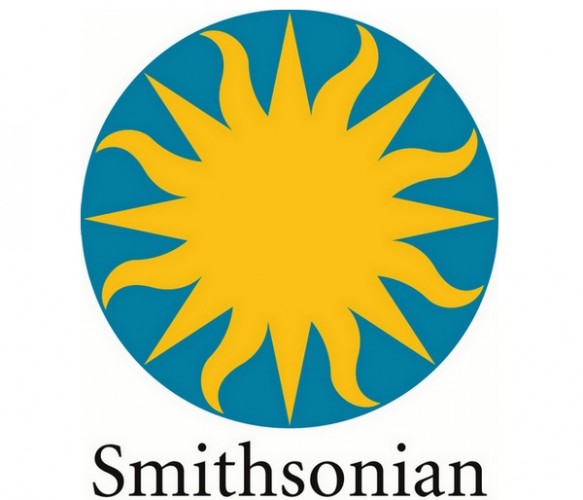Remembrance: Ivan Chermayeff, Distinguished Designer of Prominent Logos — Dead at 85
A graphic designer who created some of the most strategic corporate logos of the 20th century.

Smithsonian Logo by Chermayeff and Geismar, 1998.
By Mark Favermann
I met Ivan Chermayeff once and heard him give two lectures about his work. He was a gentleman designer, who can best be described as courtly, overly polite, and even somewhat humble. Considered one of the foremost graphic designers of the Post WWII era, Chermayeff was a founder in 1957 of what was originally Chermayeff & Geismar (now Chermayeff & Geismar & Haviv), a major New York-based design firm. He died on December 2, 2017.
Known for its crisp, bold Modernist designs that often featured primary colors, the firm was among the pioneers of creating corporate identity by means of simple abstraction and bold letterforms. This was done in part by streamlining more complicated logos and marks that had dominated corporations the first half of the 20th Century.
Among Chermayeff’s most prominent logos: the Smithsonian Institution (sunburst), Showtime, Pan Am, Mobil, NBC’s prismatic peacock, National Geographic, the Museum of Modern Art, the Library of Congress, Chase Bank’s heptagonal blue logo, Harper Collins, and the American Bicentennial Celebration. Each is bold, colorful and unique. His creative work can also be found on hundreds of posters and campaigns.

The late Ivan Chermayeff — a truly gifted gentleman of design.
His generation was not a digital one. Computers were not his tool of choice. Instead, he loved designing and working by hand. Ivan was born in London in 1932, he was the son of a distinguished Russian-born architect/educator Serge Chermayeff. Based on his heritage, his father named him Ivan for Ivan the Terrible and his younger brother brother Peter (also a prominent architect) for Peter the Great. Ivan Chermayeff was actually Ivan the Gentle.
The Chermayoff family moved to the United States when Ivan was 8 and eventually lived wherever his father’s work took them. Before graduating high school from Phillips Academy in Andover, MA, Ivan and his brother had attended numerous schools throughout the U.S. and Canada.
Ivan knew from an early age that he wanted to make art, some form, his life’s work. He also concluded that he didn’t want to be an architect, like his father. Chermayeff felt that architectural projects took a long time and often failed because of a lack of funding or civic resolve. In contrast, graphic design took a much shorter time and had a high percentage of being produced.
Initially studying at Harvard University and what is now Chicago’s ITT Institute of Design (founded to be the American Bauhaus), Ivan earned a Bachelor of Fine Arts degree from Yale School of Art and Architecture. He soon gravitated toward what was then called commercial art which at the time was not very distinct from advertising art. After Yale, his first work experiences came as an assistant to noted book designer Alvin Lustig and as a designer of album covers for Columbia Records. By the late ’60s and early ’70s the work of Chermayeff & Geismar began, along with the design accomplishments of his contemporaries, to be referred to as graphic design.
To Chermayeff, modernizing well-worn logos was as crucial a job as creating new ones. A strategic example of that approach was what he did for NBC. In 1986, he modernized NBC’s iconic Peacock by plucking five feathers and reorienting its profile from left to right.

NBC Logo by Chermayeff and Geismar, 1986.
Highly honored during his career, Chermayeff served as president of the American Institute of Graphic Arts, was the recipient of gold medals from the AIGA and from the Society of Illustrators. He was also named to the Art Directors Club Hall of Fame in 1981. The Smithsonian’s Cooper Hewitt Museum, its design museum, recognized his lifetime achievement as a designer.
A longtime faculty member of the School of Visual Arts in Manhattan, Chermayeff also taught over the years at Brooklyn College, Cooper Union, the Parsons School of Design, and elsewhere. Author of several books, he also lectured extensively throughout the United States and abroad.
Chermayeff was also a practicing visual artist who occasionally showed his 2-D and 3-D found object collages and assemblages at galleries and museums. Many of these art pieces had a very dry sense of humor.
In his later years, Chermayeff was passionately interested in our changing climate and endangered world. He felt that designers should do something meaningful about it; he felt that designers’ way of thinking, as well as their professional focus on creative problem-solving, made them exceptionally suited to the task. He argued that creative people should become more involved in society, contributing to the common good rather than just massaging their and clients’ egos. Designers need to be activists, he insisted, and do whatever they can do to improve our increasingly threatened environment. Hopefully, this call to action will be part of Chermayeff’s legacy, along with his being an example of a truly gifted gentleman of design.
An urban designer, Mark Favermann has been deeply involved in community branding, enhancing, and making more accessible parts of cities, sports venues, and key institutions. Also an award-winning public artist, he creates functional public art as civic design. Mark created the Looks of the 1996 Centennial Olympic Games in Atlanta, the 1999 Ryder Cup Matches in Brookline, MA, and the 2000 NCAA Final Four in Indianapolis. The designer of the renovated Coolidge Corner Theatre, he has been a design consultant to the Red Sox since 2002. An Associate Editor of The Arts Fuse, Mark writes on architecture, design, the fine arts and theatre.
